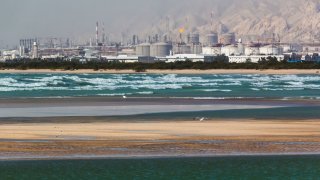Targeting Iran’s Oil Could Backfire
If Israel’s retaliation hits Iranian oil production, Saudi and Emirati energy infrastructure will come into the crosshairs.
With Iran’s decision to mount a major missile strike against Israel on October 1 in retaliation for Israel’s strike on Hezbollah’s headquarters near Beirut, which killed longtime leader Hassan Nasrallah on September 27, the regime has chosen to cross the Rubicon into direct conflict with Israel. This is very unlike the Iranian missile strike in April, which was intentionally telegraphed and resulted in only a small Israeli strike against an Iranian air defense site. Now, Israel is considering a much broader list of retaliatory options, reportedly including strikes on the IRGC, Iran’s leadership, nuclear program sites, and oil infrastructure. President Biden has already publicly opposed striking Iran’s nuclear program, concerned that it could tilt Iran toward pursuing immediate weaponization.
Oil might seem to be a logical pressure point against the Iranian regime, given its importance to the country’s economy. Iran’s oil exports have been up in 2024, contributing to restoring modest economic growth. It is arguably a problematic target for U.S. interests, though, with a high potential for blowback. In a scenario in which Iran continues to exchange blows with Israel for an extended period—which now seems likely—or even ends up clashing directly with U.S. forces in the region, Iran would still have a powerful incentive to avoid striking Saudi, Emirati, or other GCC oil and gas infrastructure. The Gulf kingdoms can field superior air forces that could damage Iran’s oil infrastructure in a manner that would take years to repair.
The mutual vulnerability of both Arab and Iranian oil infrastructure, which Iran demonstrated in its attack facilities at Abqaiq and Khurais in Saudi Arabia in 2019, could constitute a critical “firebreak” against Iran targeting Gulf Arab oil infrastructure even if they were to target U.S. bases and military forces operating in those countries as part of a continued escalation of conflict. The Saudi-Iran normalization agreement and the general improvement in relations with several GCC states in the last two years also would tend to mitigate against targeting oil infrastructure. By crossing over this firebreak intentionally, an Israeli strike on Iranian oil assets could reduce Iran’s reluctance to strike Gulf Arab oil infrastructure. One possibility that has been discussed in the media is an attack on Iran’s Abadan refinery, which could spare exports of crude oil. Yet, even an attack like this could provoke an Iranian strike in the Gulf, particularly if it involved overflight and refueling in Saudi airspace.
Coming in the context of a bearish oil market, the price impact of escalation in the Gulf has been very modest. This also reflects a structural change since the early 2010s due to the short-cycle nature of American shale oil production, in which pricing in notional risks of volume losses would lead in less than a year to actual barrels of excess supply. It also reflects deep “Iran fatigue” among oil traders since there have been repeated fears of volume losses from the Gulf due to armed conflict, and the worst fears have never come to fruition. Crude oil used to routinely move $3-$5 on nothing more than hawkish comments about Iran from Israeli ministers during the mid-2000s, but those days are long gone.
If we actually did see a successful attack on key facilities such as Abqaiq, however, the potential for a severe price shock is still very much present. The 2019 attack hit only about one-third of the facility’s capacity for sulfur gas removal. Production volumes were restored in less than a month by routing around the damaged units in a facility that operates well below capacity. However, if a larger percentage of those units were taken out of operation in another strike, the result would be very different. The key facilities are better defended now than in 2019, with the United States having helped the Saudis improve local air defenses.
Nonetheless, Iran’s capabilities have also improved. Iran could use Fateh-110 short-range ballistic missiles rather than one-way drones, which have sufficient accuracy to strike fixed targets. If Iran really wanted to cripple such facilities, a series of strikes would probably be undertaken.
The market impact of strikes on Saudi or Emirati infrastructure would have an outsize impact on the market. If there were volume losses for Iran but none for Saudi or Emirati barrels, those two producers are capable of making up the lost volume, given their current spare capacity. When Iraq invaded Kuwait in August 1990, to cite another example, Saudi and Emirati volumes more than compensated for the loss of exports from both UNSC sanctions. Yet, if the key Saudi and Emirati facilities went offline, there would be very little spare capacity anywhere else.
The potential for unintended consequences from targeting Iranian oil infrastructure is substantial. It is certainly something the Biden administration needs to discuss with Israel’s leadership before they decide to include it in their target list.
Greg Priddy is a Senior Fellow for the Middle East at the Center for the National Interest.
Image: Hamed Hoseini / Shutterstock.com.

